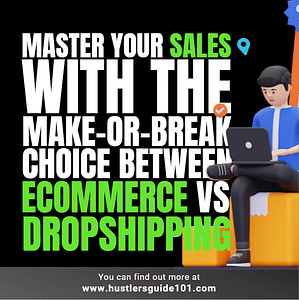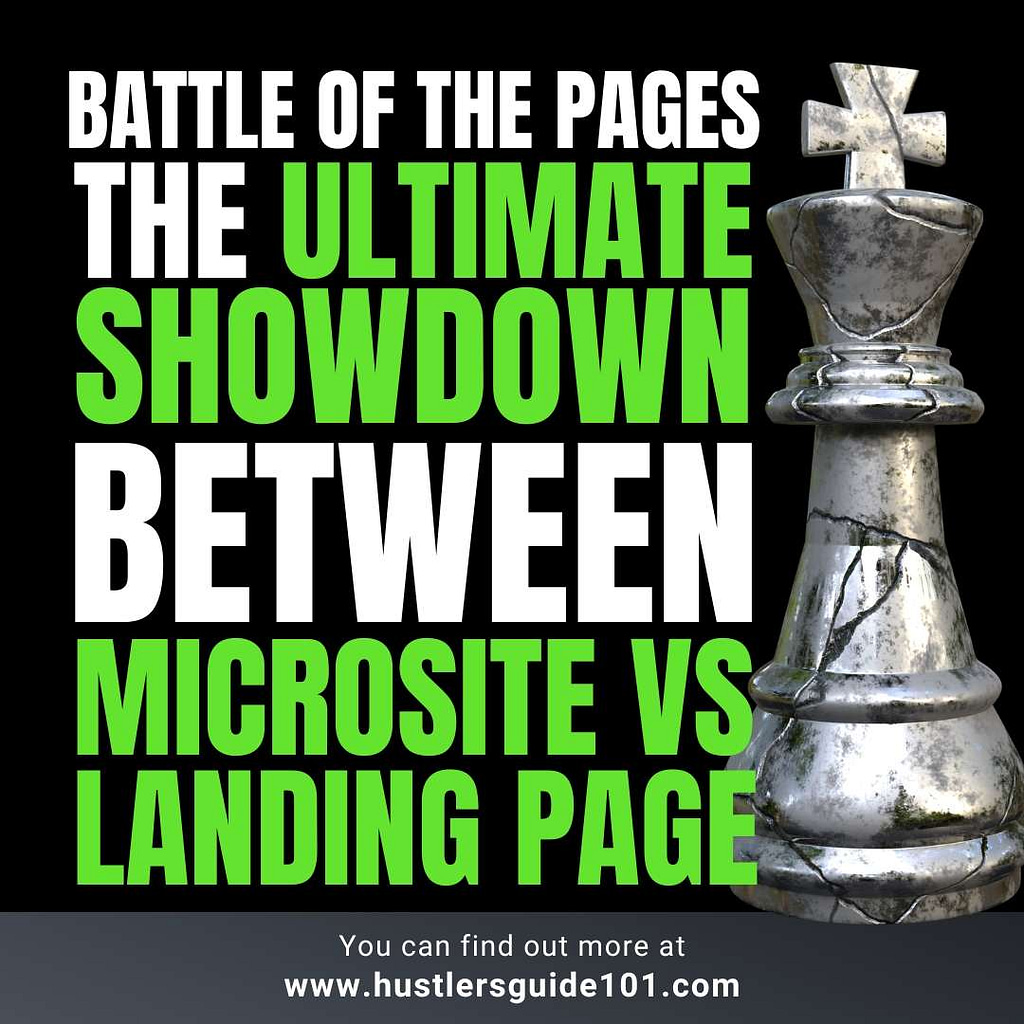
Are you feeling confused, frustrated, and overwhelmed by the endless options for creating a killer web page? Don’t worry, we’ve all been there! It can be tough to choose between a microsite VS landing page. Especially when you’re not sure which one is the right fit for your business.
But fear not, dear reader! In this blog post, I am going to help you navigate the confusing world of web pages. And find the perfect solution for your marketing needs. Together, we will break down the differences between microsites VS landing pages.
Let’s dive in and get started on this Microsite VS Landing page adventure together!
Microsites
Ah, microsites. The little siblings of a company’s main website. But what are they exactly? Well, think of them as tiny websites that are built for a specific purpose. Such as promoting a product or event.
Unlike a landing page, a microsite is also laser-focused on one particular topic but can have different pages and sections. It means you can get really creative with the design and content, and make it all about one specific thing.
The best part about microsites is they are tailored to a specific audience. This can help to increase engagement and conversion rates. Plus, they’re great for SEO because they are targeted and specific.
Overall, microsites are a fantastic way to showcase a product or event. They can help to create a buzz and excitement around your brand. Who knows, your little microsite might just become a big hit!
Advantages of microsites
- Customization and personalization: Microsites offer greater flexibility and customization options compared to other types of web pages. You can create a highly personalized experience tailored to your target audience’s interests and preferences. This can be especially effective for niche audiences or highly specific topics.
- Increased engagement and interactivity: Microsites are designed to be highly engaging and interactive. They can help boost user engagement and increase the time users spend on your site. By incorporating interactive elements such as quizzes, games, or video content, you can create a more immersive experience that resonates with your audience.
- Better search engine optimization: Microsites can also help improve your search engine rankings, as they allow you to create more targeted and specific content that’s optimized for specific keywords and search terms. This can help improve your visibility and drive more traffic to your site.
Disadvantages of microsites
- Higher cost and maintenance: Microsites are more complex and require more resources to create and maintain. They can be more expensive to develop and manage than other types of web pages. This can be a disadvantage for smaller businesses or those with limited resources.
- Difficulties with integration: Microsites can be more difficult to integrate with other marketing channels. Such as social media or email campaigns, which can limit their effectiveness in driving traffic and conversions. This can be a disadvantage if you rely heavily on these channels for your marketing efforts.
- Potential for brand confusion: They are often designed to be highly specific and focused on a single topic. This can sometimes create confusion or dilute your brand identity if not executed properly. This can be a disadvantage if you’re trying to maintain a consistent brand message across multiple channels and platforms.
Landing Pages
Oh, landing pages! These little web pages are like the Swiss Army knives of digital marketing. So, what are they? Well, a landing page is a standalone web page that’s designed with one specific goal in mind, such as getting people to sign up for a newsletter, download an ebook, or purchase a product.
Unlike microsites, which can have a lot of different pages and sections, a landing page is all about simplicity and focus. They’re usually designed with a clear call to action, which tells the user exactly what to do next.
The best part about landing pages is that they’re great for increasing conversion rates. By having a clear and simple message, and a focused call to action, users are more likely to take the desired action.
Overall, landing pages are a great tool for any digital marketer’s toolbox. They’re simple, effective, and can help to boost your online presence and sales. You might just be surprised by how powerful they can be!
Advantages of landing pages
- Simplicity and focus: Landing pages are designed with a single goal in mind, which means they can be more focused and easier for users to navigate. By keeping your messaging and design simple and streamlined, you can create a more effective user experience that encourages conversions.
- Increased conversion rates: Because landing pages are designed to be highly targeted and focused, they can often lead to higher conversion rates compared to other types of web pages. By creating a page that’s specifically tailored to your target audience and optimized for conversions, you can maximize your chances of success.
- Easier integration with other marketing channels: Landing pages can be used in conjunction with other marketing channels, such as social media or email campaigns, to drive traffic and boost conversions. Including a clear call-to-action and directing users to a dedicated landing page, you can create a seamless user experience that encourages action.
Disadvantages of landing pages
- Limited content and functionality: Because landing pages are designed to be focused and streamlined, they often have limited content and functionality compared to other types of web pages. This can be a disadvantage if you need to convey a lot of information or offer a more complex user experience.
- Less room for personalization: Landing pages are typically designed for a specific audience or goal, they may not offer as much room for personalization as other types of web pages. This can be a disadvantage if you’re trying to reach a broad or diverse audience, or if you want to offer a more customized user experience.
- Difficulty in standing out: Landing pages are so focused and targeted, it can be difficult to create a page that stands out from the competition. To be successful, you need to create a page that’s not only effective in driving conversions but also visually appealing and memorable to your target audience.
Wondering how much a landing page can cost you? Check it out here.
Microsite VS Landing Page: Differences
While both landing pages and microsites are designed to achieve specific marketing goals, they do have some key differences.
Firstly, landing pages are typically standalone web pages created with one specific goal, such as capturing leads or promoting a product. They’re usually linked to other marketing channels, like email campaigns or social media, and are designed to drive traffic to a specific action.
On the other hand, microsites are more like miniature versions of a company’s main website, but they’re focused on a specific topic or campaign. They can have multiple pages and sections and are often used to create a more immersive experience for the user.
Another key difference is in the level of customization and creativity. Microsites offer more flexibility and freedom to create something unique and engaging while landing pages are typically more streamlined and focused on a singular goal.
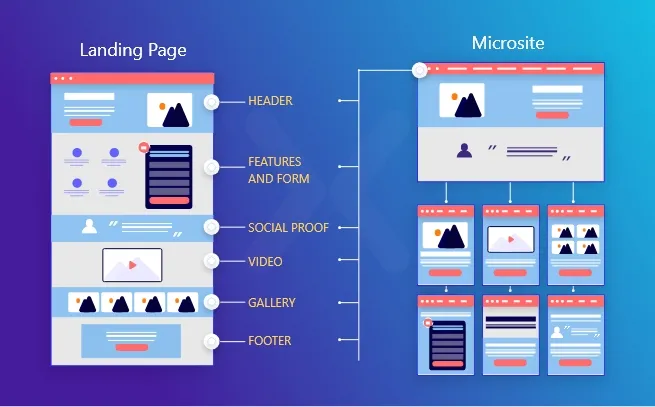
Microsite VS Landing Page: Factors to consider
But the main question is which one you should choose? Microsite VS Landing page? Let’s consider some factors for a reality check.
Marketing goals and objectives
When deciding between a microsite and a landing page, your marketing goals and objectives should be your top priority. What are you trying to achieve? Are you looking to promote a new product or service? Capture leads? Drive traffic to a specific offer or event?
Depending on your goals, you may find that a landing page is more effective in driving conversions and achieving a singular goal, while a microsite can offer more creative freedom to engage with your audience on a more intense level.
Target audience and buyer personas
Your target audience and buyer personas should also play a key role in your decision-making process. Who are you trying to reach? What are their pain points?
Depending on your audience, you may find that a microsite is more effective in creating a more immersive experience that resonates with your target audience. Alternatively, a simple and focused landing page may be more effective in capturing the attention of a specific segment of your audience.
Budget and resources
Finally, your budget and resources should also be a consideration when deciding between a microsite and a landing page. Microsites can be more expensive and time-consuming to create, as they require more design and development resources.
If you’re working with a limited budget, a landing page may be a more cost-effective option that still allows you to achieve your marketing goals. However, it’s important to remember that investing in a high-quality microsite can pay off in the long run. Creating a more memorable and engaging experience for your audience.
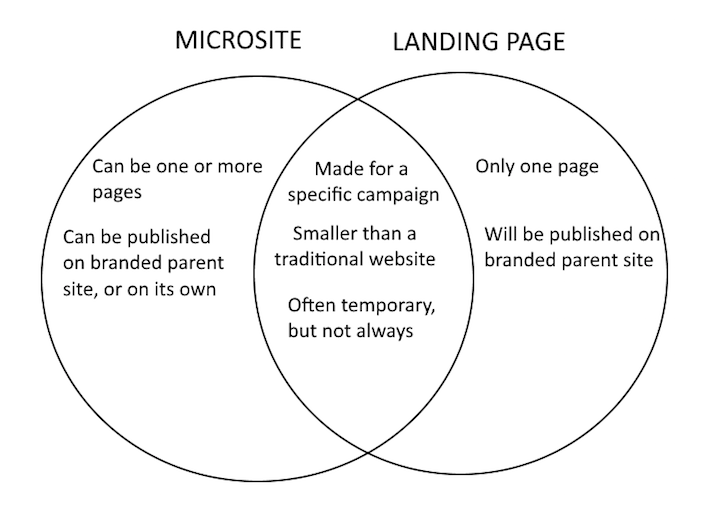
Microsite VS Landing page: Examples
Still, confused about where to use which one? Wondering if you could get some examples to relate to. Yes? It’s like I can read your mind. Let’s jump into some examples of Microsite VS landing page.
Product launches or promotions
When launching a new product or running a promotional campaign, a landing page can be an effective way to drive conversions and capture leads. A landing page can highlight the benefits and features of your product or promotion and include a clear call-to-action to encourage users to take action.
On the other hand, a microsite can be more effective if you want to create a more immersive experience for your audience, such as through interactive product demos or educational content.
Brand awareness campaigns
If your goal is to raise brand awareness and engage your audience on a deeper level, a microsite is a powerful tool. Creating a dedicated microsite that showcases your brand’s values, history, and mission, can create a more emotional connection with your audience.
A landing page is effective in building brand awareness, by highlighting key features or benefits of your product or service, and using strong visuals and messaging to capture the attention of your audience.
Lead generation and email marketing
When it comes to lead generation and email marketing, landing pages are a tried-and-true tactic. By creating a landing page that’s optimized for conversions, with a clear and compelling call-to-action, you can capture more leads and grow your email list. A microsite can also be effective in lead generation. Particularly if you want to offer more in-depth educational content or resources in exchange for user information.
However, it’s important to remember that regardless of whether you choose a landing page or microsite, your focus should be on creating valuable content that resonates with your target audience and encourages them to take action.
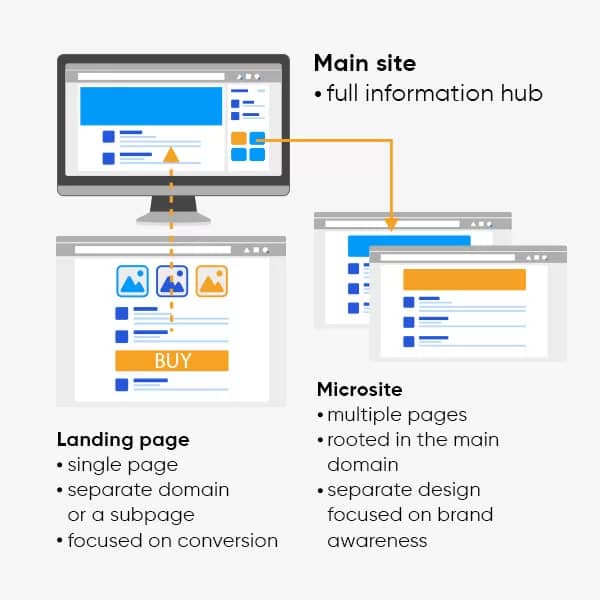
Wrapping up
And there you have it! The ultimate showdown of microsite VS landing page. It can be tough to choose which one to use. But understanding the unique benefits and drawbacks, you can make an informed decision. That will help you achieve your marketing goals.
So, whether you want to keep it simple and focused with a landing page. Or get creative and immersive with a microsite, the choice is yours! Just remember to stay true to your brand and always keep your audience in mind.
Happy marketing!
![59 Content Frameworks [50M+ Views & $10M+ sales]](https://ml7mr2tqkwmf.i.optimole.com/cb:ybm1.679b9/w:1024/h:535/q:mauto/f:best/https://hustlersguide101.com/wp-content/uploads/2023/09/ebook-for-blog.jpg)






